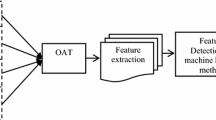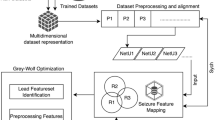Abstract
This paper proposes a novel approach to detect epilepsy seizures by using Electroencephalography (EEG), which is one of the most common methods for the diagnosis of epilepsy, based on 1-Dimension Local Binary Pattern (1D-LBP) and grey relational analysis (GRA) methods. The main aim of this paper is to evaluate and validate a novel approach, which is a computer-based quantitative EEG analyzing method and based on grey systems, aimed to help decision-maker. In this study, 1D-LBP, which utilizes all data points, was employed for extracting features in raw EEG signals, Fisher score (FS) was employed to select the representative features, which can also be determined as hidden patterns. Additionally, GRA is performed to classify EEG signals through these Fisher scored features. The experimental results of the proposed approach, which was employed in a public dataset for validation, showed that it has a high accuracy in identifying epileptic EEG signals. For various combinations of epileptic EEG, such as A–E, B–E, C–E, D–E, and A–D clusters, 100, 96, 100, 99.00 and 100 % were achieved, respectively. Also, this work presents an attempt to develop a new general-purpose hidden pattern determination scheme, which can be utilized for different categories of time-varying signals.













Similar content being viewed by others
References
Ropper A, Brown RH (2005) Principles of neurology, 8th edn. McGraw-Hill, Boston
Altunay S, Telatar Z, Erogul O (2010) Epileptic EEG detection using the linear prediction error energy. Expert Syst Appl 37(8):5661–5665
Andrzejak RG, Lehnertz K, Mormann F, Rieke C, David P, Elger CE (2001) Indications of nonlinear deterministic and finite-dimensional structures in time series of brain electrical activity: dependence on recording region and brain state. Phys Rev E. 64(6):061907 (1–8)
Fisher R, van EmdeBoas W, Blume W, Elger C, Genton P, Lee P, Engel J (2005) Epileptic seizures and epilepsy: definitions proposed by the International League Against Epilepsy (ILAE) and the International Bureau for Epilepsy (IBE). Epilepsia 46(4):470–472
Yuan Q, Zhou W, Li S, Cai D (2011) Epileptic EEG classification based on extreme learning machine and nonlinear features. Epilepsy Res 96(1–2):29–38
Kaya Y, Uyar M, Tekin R, Yıldırım S (2014) 1D-local binary pattern based feature extraction for classification of epileptic EEG signals. App Math Comp 243:209–219
Siuly Y, Lin PW (2011) Clustering technique-based least square support vector machine for EEG signal classification. Comput Methods Programs Biomed 104(3):358–372
Ojala T, Pietikäinen M, Harwood D (1996) A comparative study of texture measures with classification based on featured distributions. Pattern Recogn 29:51–59
Ojala T, Pietikäinen M, Mäenpää T (2002) Multiresolution gray-scale and rotation invariant texture classification with local binary patterns IEEE Trans. Patt Anal Mach Intell 24(7):971–987
Guyon I, Elisseeff A (2003) An introduction to variable and feature selection. J Mach Learn Res 3:1157–1182
Dash M, Liu H (1997) Feature Selection for Classification. Intell Data Anal 1:131–156
Ng KS, Yang HY, Kim S (2009) Hidden pattern discovery on event related potential EEG signals. BioSystems 97:15–27
Chang W (2000) A comprehensive study of grey relational generating. J Chin Grey Assoc 1:53–62
Kayacan E, Ulutas B, Kaynak O (2010) Grey system theory-based models in time series prediction. Expert Syst Appl 37:1784–1789
Liu SF, Lin Y (1998) An introduction to grey systems. IIGSS Academic Publisher, PA
Hsiao SW, Tsai HC (2004) Use of gray system theory in product-color planning. Color Res Appl 29(3):222–231
Lin YH, Lee PC, Chang TP (2009) Practical expert diagnosis model based on the grey relational analysis technique. Expert Syst Appl 36:1523–1528
Lin Y, Liu S (2004) A historical introduction to grey systems theory. In Proceedings of IEEE international conference on systems, man and cybernetics, The Netherlands 1: 2403–2408
Deng JL (1982) Control problems of grey system. Syst Control Lett 1:288–294
Deng JL (1989) Introduction to grey system theory. J Grey Syst 1:1–24
Lin Y, Lee H, Chang PC (2009) Practical expert diagnosis model based on the grey relational analysis technique. Expert Syst Appl 36(2):1523–1528
Menéndez LÁ, Cos Juez FJ, Lasheras FS, Riesgo JA (2010) Artificial neural networks applied to cancer detection in a breast screening programme. Math Comput Model 52(7):983–991
Subasi A (2007) EEG signal classification using wavelet feature extraction and a mixture of expert model. Expert Syst Appl 32(4):1084–1093
Übeyli ED, Güler İ (2004) Detection of electrocardiographic changes in partial epileptic patients using Lyapunov exponents with multilayer perceptron neural networks. Eng Appl Artif Intel 17(6):567–576
Kumar SP, Sriraam N, Benakop PG, Jinaga BC (2010) Entropies based detection of epileptic seizures with artificial neural network classifiers. Expert Syst Appl 37(4):3284–3291
Fathima T, Bedeeuzzaman M, Faroog O, Khan YU (2011) Wavelet based features for epileptic seizure detection. MES J Technol Manag 2(1):108–112
Guo L, Rivero D, Pazos S (2010) Epileptic seizure detection using multiwavelet transform based approximate entropy and artificial neural networks. J Neurosci Methods 193(1):156–163
Nigam VP, Graupe D (2004) A neural-network-based detection of epilepsy. Neurol Res 26(1):55–60
Srinivasan V, Eswaran C, Sriraam N (2005) Artificial neural network based epileptic detection using time-domain and frequency-domain features. J Med Syst 29(6):647–660
Orhan U, Hekim M, Ozer M (2011) EEG signals classification using the K-means clustering and a multilayer perceptron neural network model. Expert Syst Appl 38(10):13475–13481
Author information
Authors and Affiliations
Corresponding author
Ethics declarations
Conflict of interest
There is no ‘Conflict of Interest’ in the publication of the manuscript “Hidden Pattern Discovery on Epileptic EEG with 1-D Local Binary Patterns and Epileptic Seizures Detection by Grey Relational Analysis”.
Rights and permissions
About this article
Cite this article
Kaya, Y. Hidden pattern discovery on epileptic EEG with 1-D local binary patterns and epileptic seizures detection by grey relational analysis. Australas Phys Eng Sci Med 38, 435–446 (2015). https://doi.org/10.1007/s13246-015-0362-5
Received:
Accepted:
Published:
Issue Date:
DOI: https://doi.org/10.1007/s13246-015-0362-5




